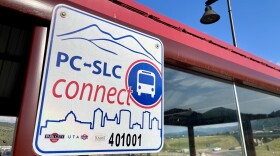Across the board, Park City and Summit County councilmembers say they’re committed to the success of bus rapid transit on state Route 224.
It’s a system of more frequent buses, bus lanes and stoplight technology — years in the making — for one of the only two roads into the largest concentration of skiable acreage in Utah.
“This is it,” High Valley Transit Executive Director Caroline Rodriguez said to close HVT’s presentation at the two council’s joint Nov. 18 meeting. “At no other time have you as the councilmembers and us, as your collective transportation team, been so well-positioned to make a significant impact in mitigating current and future transportation conditions — and we will succeed.”
She needed both councils' support before putting pen to paper on construction designs. High Valley Transit is putting out a call for contractors Wednesday, then picking one next month. Construction would start next year.

Until the designs are done, High Valley Transit won’t have exact numbers on how much it will cost either government. It told them both $20 million would be the worst-case scenario — if grants don’t come through or labor and materials costs balloon, for instance.
Park City had told HVT it couldn't have the Nov. 18 meeting without the estimate. The number was a bigger sticking point for some Park City’ councilmembers than it was for Summit County’s.
Park City Councilmember Ed Parigian wondered about the value of improving the bus station at Thaynes Canyon and Snow Creek Plaza. Councilmember Jeremy Rubell wasn’t sure about the value of bus lanes between Canyons Village and Kearns Boulevard.
Rubell said that’s different than a monetary concern, but the distinction didn’t make sense to Summit County Councilmember Canice Harte. He echoed his county colleague Chris Robinson’s question: wouldn’t Park City want bus rapid transit, as proposed, if they didn’t have to pay for it?
“Every time we start to explain those arguments, dollars keep getting thrown back into it,” the county councilmember said. “So it kind of brings me back to Chris's question…”
“I think it's value,” Rubell said.
“Value for money spent,” Park City Councilmember Bill Ciraco added.
“That's fair, so it's money,” Harte said.
“No, it's value,” Rubell said again.
Several years prior, the city’s project costs were estimated at roughly $6 million. The new $20 million number is based on the newest designs and inflation, but Ciraco said the government contribution increased by a larger percentage than the overall budget.
The total project budget is currently around $100 million, and it is more than half funded already, mostly with state and federal grants.
Bus rapid transit involves widening state Route 224 from 82 feet to 92 feet across to accommodate the new lanes from Kimball Junction to Kearns Boulevard. That’s almost 20 feet less wide than before, minimizing both the cost and footprint.
After Kearns, buses are aided by turn lanes and technology that gives them more green lights within Park City.
Along the route, bus stops at Bear Hollow and Thaynes Canyon would see similar improvements to Fresh Market's bus station.
HVT estimates the bus rapid transit system would be 25 minutes faster than cars between Kimball Junction and the Old Town Transit Center during peak winter conditions.
Before the transit authority secured support Nov. 18, some on the Summit County Council seemed worried the abovementioned Park City councilmembers were reserving the right to say “no” at the eleventh hour.
“I feel like I'm reliving the housing authority discussion — where staff has worked for a very long time to tee up something that I believed we have consensus on in this room — that then got canned in January,” Councilmember Roger Armstrong said.
Read more: Park City, Summit County councils punt housing authority decision
Those Park City leaders objected that words were being put in their mouths. They said they’re not saying “no” at all.
“It's actually a pretty fair comparison to the housing authority,” Rubell said. “Everyone's entitled to their own opinion, but not their own facts. We didn't have consensus. We had questions, and when those questions were answered, it gave us some pause if that's the best value for our taxpayer money and the best benefit for our community.
Rodriguez was not prepared to take “no” for an answer to the question of whether Park City wants bus rapid transit Nov. 18.
She said that puts funding at risk. When High Valley Transit applied for grants, it said the bus service would run between Kimball Junction and Old Town.
And if Park City were to decide not to partner on bus rapid transit, Rodriguez worries she’d need to hand back $25 million in federal funding and $30 million in state funding.
“High Valley Transit and the county are not going to go back to UDOT and say, ‘We promised we would deliver on this project, where all the data says it will be successful and a benchmark,’” Rodriguez said. “We're not going to do that.”
She told the Park City Council it would have to do that.
Despite some on the council wanting more information before making a decision — some of which High Valley Transit claimed it provided to Park City Municipal employees already — every councilmember gave their verbal support Nov. 18.
High Valley Transit is an independent, standalone entity from Summit County. Nearly all of its funding comes from a county and city transportation sales tax.



